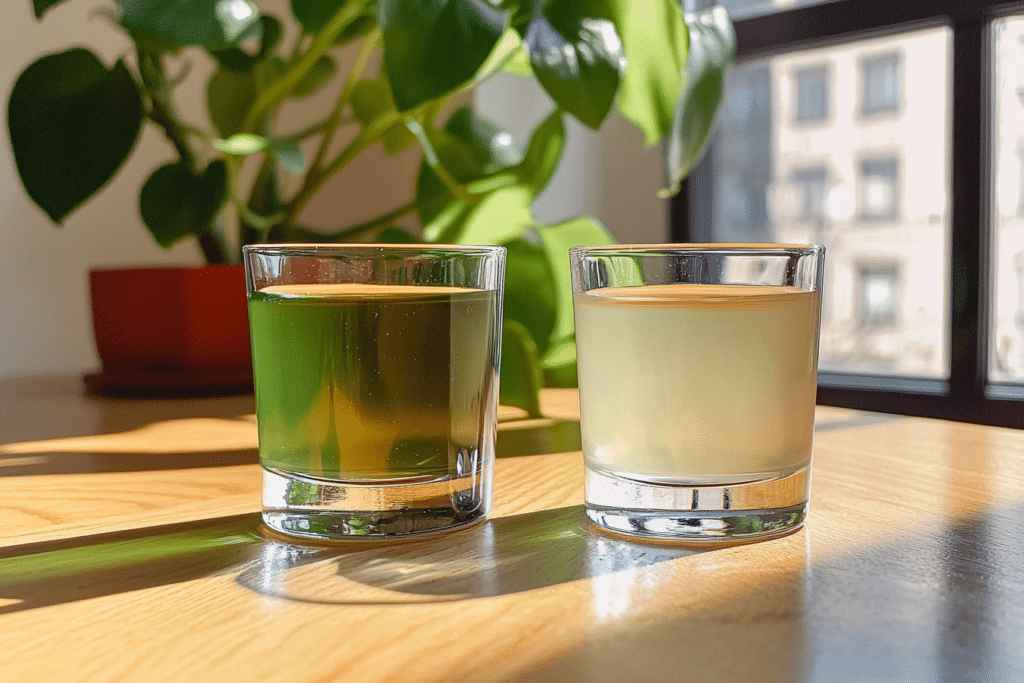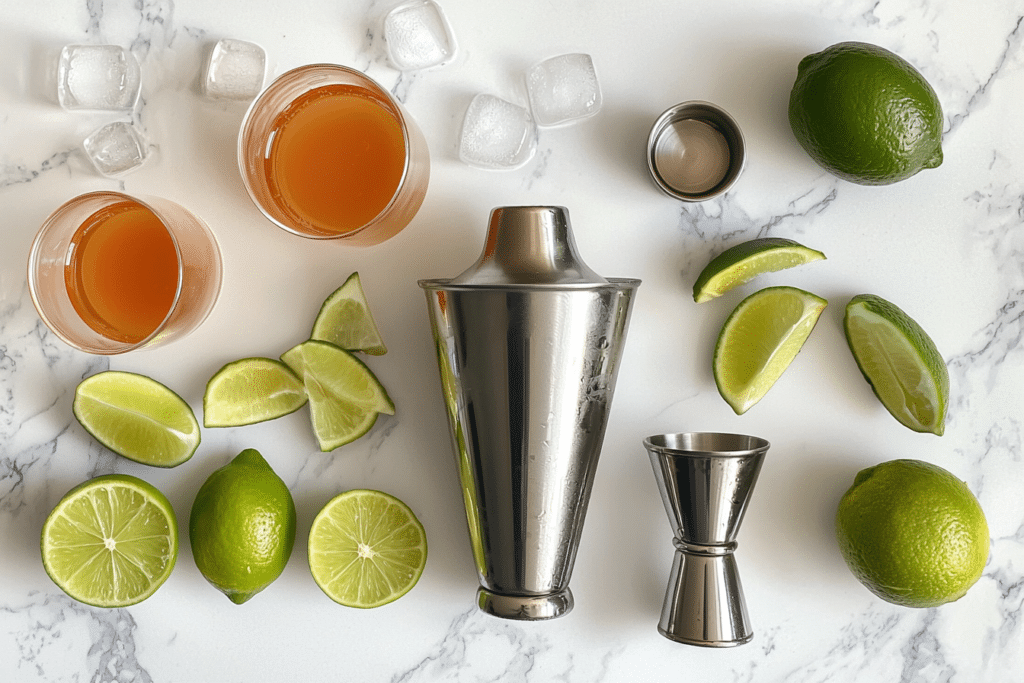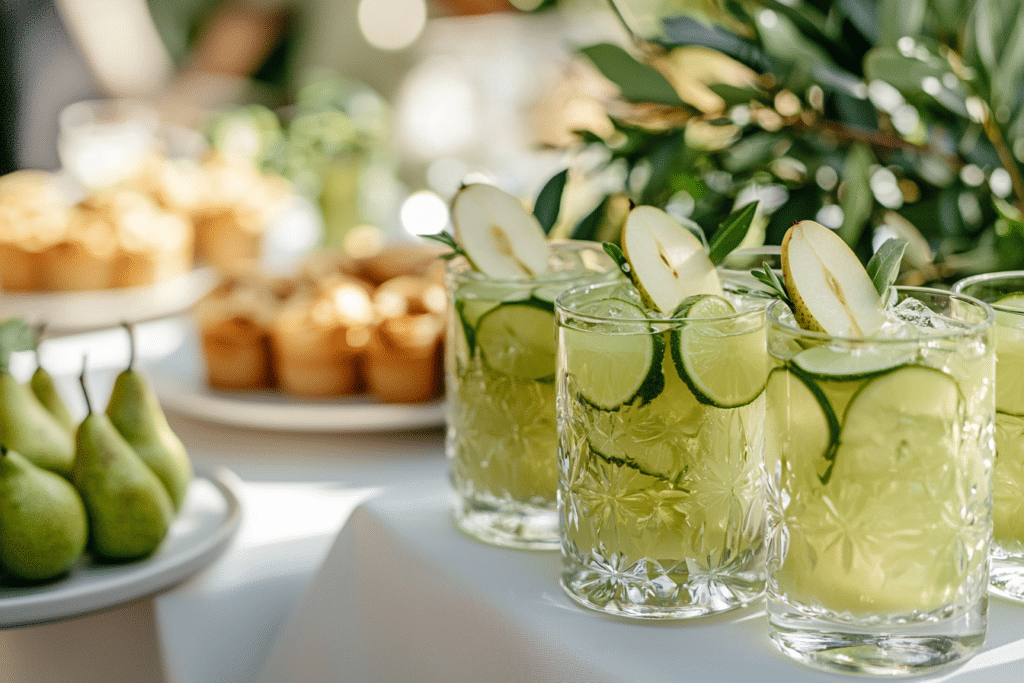1. Introduction
Tea-based mocktails have become a staple in gatherings, with the white tea shot vs green tea shot debate taking center stage. Despite their names, these popular drinks don’t actually contain tea but are inspired by their vibrant colors and refreshing flavors. This guide explores the differences to help you pick your favorite.
Both options are made with a mix of fruity and tangy ingredients. In contrast, their base components create distinct differences in flavor, intensity, and appeal. Moreover, understanding these variations can ultimately help you choose the option that best matches your preferences and complements the occasion. Whether you enjoy bold flavors or prefer lighter, more subtle profiles, each drink offers something unique.
In this article, we’ll delve into the details of green tea and white tea shots, comparing their ingredients, flavors, and cultural appeal. By the end, you’ll know exactly which shot to order or prepare for your next gathering. For more exciting mocktail and drink recipes, visit the Oven Warm Recipes Home for inspiration.
1.1 What Are Tea Shots?
When it comes to a white tea shot vs green tea shot, the names reflect the colors of these mocktails rather than the presence of actual tea. Interestingly, despite their names, green tea shots and white tea shots don’t contain any tea at all. Instead, they derive their names from their vibrant colors, which closely resemble brewed green and white tea. These shots are known for their balance of sweetness and tang, making them a hit at parties and bars.
1.1.1 Origins of Green Tea and White Tea Shots
The green tea shot gained fame as a bar staple, appealing to whiskey drinkers looking for a fun, approachable drink. Bartenders embraced its simplicity and crowd-pleasing flavor. The white tea shot, in contrast, emerged as a lighter and subtler alternative, offering a refreshing option for those who prefer delicate flavors. Its neutral flavor allows the fruity and tangy elements to shine, making it a favorite among those who prefer milder alcoholic beverages.
1.1.2 The Name’s Influence
The names “green tea shot” and “white tea shot” are clever marketing tools that pique curiosity. Their unique monikers often lead people to wonder if they contain actual tea, which adds an element of intrigue and serves as a conversation starter.
1.2 The Core Ingredients: A Comparison
The primary distinction between green tea shots and white tea shots lies in their base liquors. While both share some common mixers, their unique ingredients create entirely different flavor profiles.
1.2.1 Green Tea Shot Ingredients
The green tea shot is a whiskey-based cocktail that combines sweet, tangy, and slightly fizzy elements. Its key ingredients include:
- Jameson Irish Whiskey: Adds warmth and depth, giving the shot its bold edge.
- Peach Schnapps: Provides fruity sweetness that balances the whiskey’s sharpness.
- Sour Mix: Delivers the tangy kick that complements the other ingredients.
- Lemon-Lime Soda: Adds a fizzy finish, making the drink light and refreshing.
Flavor Profile:
The whiskey base gives green tea shots a robust and slightly grassy taste. This is balanced by the sweetness of peach schnapps and the tanginess of sour mix, resulting in a flavorful and satisfying drink.
1.2.2 Key Ingredient Differences
The main difference lies in the base liquor:
- Green tea shots use whiskey for a bold, complex flavor.
- White tea shots use vodka for a lighter, smoother taste.
1.3 White Tea Shot vs Green Tea Shot: Flavor Profiles Compared
The flavor profiles of green tea shots and white tea shots are what make them so appealing. These drinks balance sweet and tangy elements, creating refreshing and enjoyable experiences for a wide range of palates.

1.3.1 Green Tea Shot Flavor
Green tea shots are known for their vibrant and slightly tangy taste, which combines sweetness with a zesty edge. The fruity notes complement the refreshing finish, making it ideal for those who enjoy bold and well-rounded flavors.
1.3.2 White Tea Shot Flavor
White tea shots, in contrast, are lighter and subtler. They emphasize a smoother sweetness, with a delicate tang that doesn’t overpower. This makes them a great option for individuals who prefer gentler and more refined flavors.
1.3.3 How the Flavors Compare
- Sweetness: Both shots are sweet, but green tea shots have a bolder fruity flavor, while white tea shots are softer and more delicate.
- Tanginess: Green tea shots offer a sharper tang, while white tea shots provide a milder citrusy finish.
Quick Tip: For non-alcoholic versions, adding natural fruit juices like peach or lemon can enhance these flavor profiles while keeping the drinks refreshing and vibrant.
1.4 Preparation and Serving: Non-Alcoholic Versions
Creating non-alcoholic versions of green tea shots and white tea shots allows everyone to enjoy their vibrant flavors without the need for alcohol. For detailed instructions and additional variations, check out our Green Tea Shot Recipe page. These mocktails are easy to prepare and perfect for parties, gatherings, or casual sipping. Explore a variety of creative non-alcoholic tea-based drink recipes for inspiration and flavor combinations here.

1.4.1 Mocktail Recipe: White Tea Shot vs Green Tea Shot
Ingredients:
- 2 oz green tea (brewed and chilled)
- 1 oz peach nectar
- 1 oz fresh lemon juice
- Splash of sparkling water
Instructions:
- Combine the chilled green tea, peach nectar, and lemon juice in a shaker with ice.
- Shake vigorously for 10-15 seconds to mix the flavors thoroughly.
- Strain into a shot glass or small serving glass.
- Add a splash of sparkling water for a fizzy finish.
- Garnish with a lemon slice or a mint sprig for added presentation.
1.4.2 How to Make a Non-Alcoholic White Tea Shot
Ingredients:
- 2 oz white tea (brewed and chilled)
- 1 oz pear juice
- 1 oz fresh lime juice
- Splash of soda water
Instructions:
- Mix the chilled white tea, pear juice, and lime juice in a shaker filled with ice.
- Shake until well-combined and cold.
- Strain the mixture into a shot glass.
- Top with soda water for a light, bubbly effect.
- Garnish with a thin pear slice or lime wedge for a polished look.
1.4.3 Tips for Perfect Mocktails
- Balance the Sweetness and Tang: Adjust the peach or pear juice and citrus amounts to suit your taste.
- Chill Everything: Ensure all ingredients are well-chilled for the best flavor and texture.
- Garnish Creatively: Fresh fruit, edible flowers, or herbs like mint can elevate the presentation.
1.5 Popularity and Cultural Appeal
The white tea shot vs green tea shot comparison often sparks discussions about flavor preferences and occasions. To learn more about how green and white tea stack up, read our comparison of Which Is Better: Green Tea or White Tea. These mocktails have carved a niche in social settings, becoming staples at gatherings and parties. Tea-based drinks are not just flavorful but also bring numerous health benefits, as detailed here.

1.5.1 Green Tea Shots: Vibrant and Fun
Green tea shots are loved for their bright color and bold flavor, making them a go-to choice for social occasions. Their unique combination of tangy and sweet notes sparks conversations and brings energy to any gathering.
- Visual Appeal: The vibrant green hue is eye-catching and perfect for themed parties or social media photos.
- Adaptability: Green tea shots can be enjoyed by all, thanks to the versatility of their non-alcoholic version.
1.5.2 White Tea Shots: Subtle and Sophisticated
White tea shots offer a more subtle flavor profile, appealing to those who prefer lighter and more refined tastes. Their softer color and delicate sweetness make them a hit at elegant events and casual get-togethers alike.
- Visual Appeal: The pale, golden tone reflects their light and refreshing nature.
- Inclusive Enjoyment: Their non-alcoholic preparation ensures that guests of all preferences can partake.
1.5.3 Why They’re Loved Across Cultures
These tea-based mocktails have transcended traditional boundaries, finding fans worldwide:
- In the West: Their colorful appearance and fruity flavors make them a staple at parties.
- In the East: Their tea-inspired names resonate with cultural appreciation for tea-based beverages.
1.6 White Tea Shot vs Green Tea Shot: How to Choose
Deciding between green tea shots and white tea shots often comes down to personal preferences and the occasion. Both mocktails have their unique strengths, making them ideal for different situations. When deciding between these drinks, consider sustainability practices in tea farming. Learn more about them here.”
1.6.1 When to Choose a Green Tea Shot
- Bold Flavors: If you enjoy strong, tangy, and fruity flavors, green tea shots are the perfect choice.
- Energy and Vibrancy: Their refreshing and bold taste adds excitement to lively gatherings or themed parties.
- Thematic Occasions: Their bright green hue makes them a fun addition to spring or summer events.
Best Served At:
- Outdoor barbecues
- Casual get-togethers
- Celebrations with bold themes
1.6.2 When to Choose a White Tea Shot
- Delicate and Light: If you prefer softer and subtler flavors, white tea shots are more suited to your palate.
- Sophistication: Their refined taste and appearance make them ideal for elegant or relaxing settings.
- Inclusivity: The milder flavor profile ensures they appeal to a wide range of preferences.
Best Served At:
- Formal events or dinners
- Intimate gatherings
- Mindful, relaxing moments
1.6.3 Serving Both for Variety
Why not cater to everyone by offering both?
- Green Tea Shots: For those who enjoy bolder flavors and vibrant aesthetics.
- White Tea Shots: For guests seeking a lighter, more soothing option.
Providing both options allows you to enhance the experience and ensure everyone finds something they enjoy.
1.7 FAQs About Green Tea and White Tea Shots
Here are some frequently asked questions about green tea shots and white tea shots. These answers can help you understand their appeal and guide you in choosing the right option.
1.7.1 Do green tea shots or white tea shots contain actual tea?
No, neither contains actual tea. Their names refer to their colors, which resemble brewed green or white tea.
1.7.2 Which shot is sweeter?
White tea shots are generally sweeter due to their subtler flavor profile, whereas green tea shots offer a tangier and bolder taste.
1.7.3 Are there non-alcoholic versions of these shots?
Yes, both can be made as mocktails using ingredients like brewed green or white tea, fruit juices, and sparkling water. Furthermore, these versions cater to a wider audience.
1.7.4 Which is better for parties?
Green tea shots are ideal for lively parties due to their bold flavors and vibrant appearance. In contrast, white tea shots suit more relaxed events.White tea shots are better for smaller gatherings or elegant events.
1.7.5 How do the calories compare?
Calories vary based on the ingredients used. Non-alcoholic versions with fresh fruit juices and no added sugars are generally lower in calories. Therefore, they are a healthier option for all age groups.
1.7.6 Can children enjoy these mocktails?
Yes, non-alcoholic versions of these shots are safe and enjoyable for children, particularly when made with natural juices and tea.
1.7.7 What’s the best garnish for green tea shots?
Mint leaves or lime wedges complement green tea shots well.
1.7.8 What’s the best garnish for white tea shots?
Pear slices or a sprig of thyme add a sophisticated touch to white tea shots.
1.7.9 Which shot is better for beginners?
White tea shots are milder and more approachable, making them better for those new to tea-based mocktails.
1.7.10 Can these mocktails be served as full beverages?
Yes, you can increase the portion sizes and serve them over ice for a refreshing, non-alcoholic cocktail.
1.8 Conclusion
Whether you choose a white tea shot vs green tea shot, both offer unique flavors and versatility to suit your mood or event. Moreover, their vibrant and refreshing profiles ensure they remain popular, regardless of whether you prefer bold and tangy tastes or light and subtle flavors.
For those seeking a lively and energetic option, green tea shots deliver a bright color and zesty punch that’s perfect for celebrations. Meanwhile, white tea shots provide a softer, sweeter alternative, ideal for sophisticated events or relaxed gatherings. Additionally, the non-alcoholic versions ensure that everyone, irrespective of their preferences, can enjoy these delightful drinks.
Ultimately, the choice between green tea and white tea shots depends on personal taste and the mood of the occasion. Why not try both and see which one becomes your favorite?
Call to Action:
Experiment with these mocktail recipes and elevate your next event with their refreshing flavors. Share your experience and let us know which shot you love the most!
